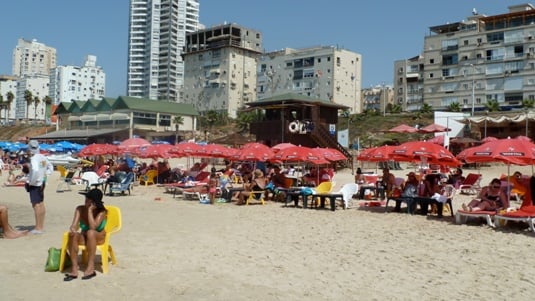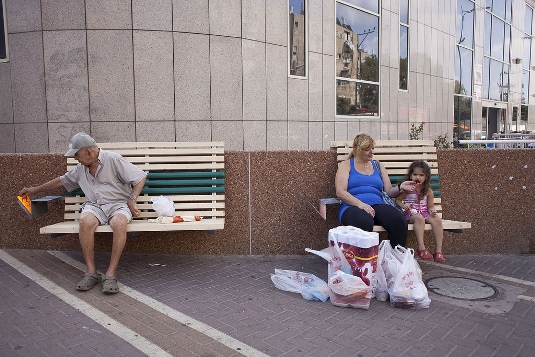
October 20, 2010
International Biennale of Landscape Urbanism
On the Way to the Beach, by Derman Verbakel Architecture. Photo: Yuval Tebol.The global cycle of recurring architecture exhibitions—biennales, triennales, and expos—has a nearly impossible balance to manage. Installations can be dismissed as too artsy, but technical presentations aren’t exactly crowd pleasers. To make matters worse, these exhibition programs send projects hurtling through a flash-in-the-pan lifecycle: […]
On the Way to the Beach, by Derman Verbakel Architecture. Photo: Yuval Tebol.
The global cycle of recurring architecture exhibitions—biennales, triennales, and expos—has a nearly impossible balance to manage. Installations can be dismissed as too artsy, but technical presentations aren’t exactly crowd pleasers. To make matters worse, these exhibition programs send projects hurtling through a flash-in-the-pan lifecycle: design, build, exhibit, deconstruct, and, in many cases, discard. Even works that are now considered iconic—Mies van der Rohe’s Barcelona Pavilion or Le Corbusier’s Pavilion de l’Esprit Nouveau—could not escape the forced obsolescence of this cycle.
Tel Aviv landscape architect Yael Moria-Klain and cultural theorist Sigal Barnir have short-circuited this dilemma, proposing an alternate model for exhibitions with the recent International Biennale of Landscape Urbanism in Bat Yam, Israel. Now in its second year, the program doesn’t ask architects and landscape architects for projects to be displayed temporarily. Instead, the organizers ask participants to design site-specific installations for the city of Bat Yam with a big caveat: no one takes them down once the Biennale is over. To layer on added significance, the projects are not meant to remediate challenges facing the city.
 Bat Yam beach. Photo: John Gendall.
Bat Yam beach. Photo: John Gendall.
Bat Yam is ideal for this type of experimentation. Located to the south of Tel Aviv, it is geographically contiguous with the metropolitan region, but politically distinct, allowing it to skirt the bureaucratic entanglements that a larger city like Tel Aviv may have imposed. In a story familiar to many American cities, it has suffered from a post-industrial economic and infrastructural decline that has left derelict parcels of land and higher crime rates in its wake. Though it borders Tel Aviv and the beach, Bat Yam, in the past, has strangely suffered from a lack of connectivity to both. With the help of programs like this Biennale, it is in the process of reconstituting itself as a hub for the creative class.
Though Bat Yam’s main public space happens to be a broad beach with fine sand and warm blue water, a series of obstacles—a road, construction sites, and restaurants and private pools—have restricted easy access to the waterfront. Several Biennale projects aim to stitch the two areas together. “On the Way to the Sea,” an installation by Tel Aviv-based firm Derman Verbakel, creates a public space between city and beach, using circular, interlocking concrete slabs to open a physical corridor. Simple white frames (not unlike soccer goal posts) animate the space and support shading canopies. The architects designed tables and benches, which, on one end, attach to the white frames, and, on the other, are supported by a wheel, allowing visitors to rotate the furniture.
 On the Way to the Beach, by Derman Verbakel Architecture. Photo: John Gendall.
On the Way to the Beach, by Derman Verbakel Architecture. Photo: John Gendall.
Further down the beach, a construction site blocks pedestrian and visual access to the water. Derman Verbakel perforated the aluminum construction fence, creating visual corridors and spaces for planter boxes. In Bat Yam, these construction fences are something of an urban leitmotif, so the Biennale directed several of its projects toward remediating the public experience that the fences compromise. Some, like Maya Barkai’s “Men at Work” and Shiri Cnaani’s “The Good Fence,” become canvases for public art while others like Noa Biran and Roy Talmon’s “Blind Fence” call for perforations to break the visual barrier.
 Blind Fence, by Noa Biran, Roy Talmon. Photo: Tamir Zadok.
Blind Fence, by Noa Biran, Roy Talmon. Photo: Tamir Zadok.
Other projects tackle specific environmental issues. A butterfly pavilion designed by a collaboration of Israeli architects, transforms a neglected site into a habitat for the region’s large, but dwindling, butterfly population. Near the beach access point opened up by “On the Way to the Sea,” local architect Ofer Bilik collaborated with Jakub Szczesny, from Poland, on a design for a water-producing playground. Several years ago, longstanding water scarcity conditions prompted the city to forbid vegetation in children’s play areas. Bilik and Szczesny designed a see-saw that pumps water from beneath the sand into small tanks dispersed on the nearby dunes, where it is desalinated through solar-driven evaporation. This fresh water irrigates nearby plants, which will combat dune erosion along the beach, and which could provide a way to circumvent irrigation prohibitions at other playgrounds throughout the city.
 Tamagotchi Park, by Ofer Bilik, Jakub Szczesny . Photo: Tamir Zadok.
Tamagotchi Park, by Ofer Bilik, Jakub Szczesny . Photo: Tamir Zadok.
In some cases, architects turned to program as a way to resuscitate areas. Italians Matilde Cassani and Francesco Librizzi designed “Extra Retail Units”—mobile kiosks that they gave to shopkeepers as a way to expand retail possibilities onto sidewalks and public areas, often transforming unused or poorly used spaces into busy food stands or clothing stores. One of the most vibrant programs was “72 Hour Urban Action,” an enterprise that brought international teams to participate in what its organizers called “the world’s first real-time architectural competition.” At the Biennale opening on September 27th, the “72 Hour Urban Action” instigator, Tel Aviv architect Kerem Halbrecht, issued ten teams each different design challenges, a small budget, and 72 hours to design and build a project. Impressively, the teams responded with works that were both thoughtful and nicely executed—shade structures that provide relief at a school and a retirement community, movable street furniture, a gateway into a housing project, and trellises for planting.
 Northern Gate, 72 Hour Urban Action, Team: But, Yam. Photo: Mor Arkadir.
Northern Gate, 72 Hour Urban Action, Team: But, Yam. Photo: Mor Arkadir.
The Biennale curators seized on one of Israel’s architectural peculiarities: the line between temporary and permanent is, at best, blurry. Projects meant to be temporary can live on for decades, while other works conceived as more permanent can have short lives. They concede that the municipality may need to take down some of the installations in the near or distant future, but, for the time being and the foreseeable future, the city is left with a collection of projects that each aspire to improve its public domain.
John Gendall is a New York-based writer, contributing to Metropolis, Architect, and Azure. He teaches architectural studies at Parsons and Pratt.





